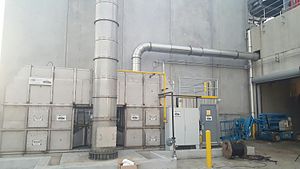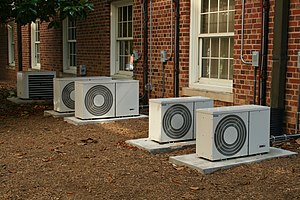廃熱
出典: フリー百科事典『ウィキペディア(Wikipedia)』 (2022/03/28 01:39 UTC 版)
ナビゲーションに移動 検索に移動概略
廃熱は、元のエネルギー源よりも有用性が低くなる(熱力学の用語で言えば、「エクセルギーが低くなる」、あるいは「エントロピーが高くなる」)。この発生源には、あらゆる種類の人間活動、自然活動、すべての生物が含まれる。たとえば、白熱電球が熱くなる、冷蔵庫が室内の空気を暖める、混雑した建物の中が暑くなる、エンジンの生成する高温の排気ガス、電子部品が動作中に熱を持つ、などがある。
環境に放出する、つまり文字通り熱を廃棄する代わりに、廃熱(または冷廃熱)を別の目的で使用したり(たとえば、高温になったエンジン冷却水を使用して車内を暖房する)、必要な熱の一部を取り戻す(たとえば建物の熱交換型換気システム)といった形で再利用することもある。
熱または冷気を短期的あるいは長期的に貯蔵(蓄熱)することで、廃熱(または冷廃熱)を有効活用したり無駄を減らすことができる。一例として、夜間の暖房を補助するためにバッファータンクに空調設備の廃熱を蓄えるものがある。スウェーデンの工場では季節間蓄熱(STES)によって、熱交換器を備えた掘削穴のある岩盤に何ヶ月も後まで蓄えられ、必要に応じて隣接する工場の暖房に使用される[1]。STESを使用して自然廃熱を使用する例とは、カナダのアルバータ州の実験都市ドレイク・ランディング・ソーラーコミュニティ(DLSC)がある。これは、季節間蓄熱に必要な熱の97%をガレージの屋根の上に設置された太陽集熱器から得ている[2] [3]。他のSTESの運用法としては、夏場の空調(冷房)に備えて、冬の低温を地下に貯蔵しておくというものがある[4]。
生物学的観点では、すべての生物は代謝過程の一部として廃熱を生み出す。周囲温度が高すぎて、この熱を排出できない場合は、死に至ることになる。
人為的な廃熱は、都市部のヒートアイランド現象の原因とも考えられている。単体での廃熱の最大の発生源は、機械(鉄鋼・ガラスなどの製造業や発電機など)と建物の外装からの放射熱である。また、自動車などの輸送用機器による燃料の燃焼も、廃熱の大きな原因である。
エネルギー変換
エネルギー源(燃料)に含まれるエネルギーを機械的仕事または電気エネルギーに変換する機械は、副産物として熱を生成する。
- ^ Andersson, O.; Hägg, M. (2008), "Deliverable 10 - Sweden - Preliminary design of a seasonal heat storage for IGEIA – Integration of geothermal energy into industrial applications, pp. 38–56 and 72–76, retrieved 21 April 2013
- ^ Wong, Bill (June 28, 2011), "Drake Landing Solar Community" Archived 2016-03-04 at the Wayback Machine., IDEA/CDEA District Energy/CHP 2011 Conference, Toronto, pp. 1–30, retrieved 21 April 2013
- ^ Wong B., Thornton J. (2013). Integrating Solar & Heat Pumps. Archived 2013-10-15 at the Wayback Machine. Renewable Heat Workshop.
- ^ Paksoy, H.; Stiles, L. (2009), "Aquifer Thermal Energy Cold Storage System at Richard Stockton College" Archived 2014-01-12 at the Wayback Machine., Effstock 2009 (11th International) - Thermal Energy Storage for Efficiency and Sustainability, Stockholm.
- ^ “Annual Electric Generator Report”. U.S. Energy Information Administration. (2018年1月1日)
- ^ このため、現行の高効率火力発電所はコンバインドサイクル発電を行う。まず燃料を燃やしてガスタービンを回して発電し、その排気(廃熱)を使って蒸気を作って蒸気タービンを回して発電する。これにより効率は大幅に改善され、2018年3月時点で世界最高効率の西名古屋火力発電所では62%に達する。参照:“中部電、西名古屋火力の熱効率62%超 世界最高水準を実現”. 日刊工業新聞 電子版 (2017年11月1日). 2022年3月28日閲覧。
- ^ Fernández-Yáñez, P. (2021). “Thermal management of thermoelectric generators for waste energy recovery”. Applied Thermal Engineering 196: 117291. doi:10.1016/j.applthermaleng.2021.117291.
- ^ “New Technologies' Wasted Energies” (英語). CNRS News. 2018年7月6日閲覧。
- ^ “A computer model of human thermoregulation for a wide range of environmental conditions: the passive system”. J. Appl. Physiol. 87 (5): 1957–72. (November 1999). doi:10.1152/jappl.1999.87.5.1957. PMID 10562642.
- ^ Fernández-Yáñez, P. (2021). “Thermal management of thermoelectric generators for waste energy recovery”. Applied Thermal Engineering 196: 117291. doi:10.1016/j.applthermaleng.2021.117291.
- ^ Gunawan, A; Lin, CH; Buttry, DA; Mujica, V; Taylor, RA; Prasher, RS; Phelan, PE (2013). “Liquid thermoelectrics: review of recent and limited new data of thermogalvanic cell experiments”. Nanoscale Microscale Thermophys Eng 17 (4): 304–23. Bibcode: 2013NMTE...17..304G. doi:10.1080/15567265.2013.776149.
- ^ Quoilin, Sylvain; Broek, Martijn Van Den; Declaye, Sébastien; Dewallef, Pierre; Lemort, Vincent (1 June 2013). “Techno-economic survey of Organic Rankine Cycle (ORC) systems”. Renewable and Sustainable Energy Reviews 22: 168–186. doi:10.1016/j.rser.2013.01.028 2018年5月7日閲覧。.
- ^ Simone Buffa (2019), “5th generation district heating and cooling systems: A review of existing cases in Europe”, Renewable and Sustainable Energy Reviews 104: 504–522, doi:10.1016/j.rser.2018.12.059
- ^ “Glossary of Meteorology”. AMS. 2009年2月26日時点のオリジナルよりアーカイブ。2022年3月28日閲覧。
- ^ “Heat Island Effect: Glossary”. United States Environmental Protection Agency (2009年). 2009年4月20日時点のオリジナルよりアーカイブ。2009年4月6日閲覧。
- ^ Zhang, Xiaochun (2015). “Time scales and ratios of climate forcing due to thermal versus carbon dioxide emissions from fossil fuels”. Geophysical Research Letters 42 (11): 4548–4555. Bibcode: 2015GeoRL..42.4548Z. doi:10.1002/2015GL063514.
- ^ a b Flanner, M. G. (2009). “Integrating anthropogenic heat flux with global climate models”. Geophys. Res. Lett. 36 (2): L02801. Bibcode: 2009GeoRL..36.2801F. doi:10.1029/2008GL036465.
- ^ Block, A., K. Keuler, and E. Schaller (2004). “Impacts of anthropogenic heat on regional climate patterns”. Geophysical Research Letters 31 (12): L12211. Bibcode: 2004GeoRL..3112211B. doi:10.1029/2004GL019852.
- ^ Chaisson, E. J. (2008). “Long-Term Global Heating from Energy Usage”. Eos 89 (28): 253–260. Bibcode: 2008EOSTr..89..253C. doi:10.1029/2008eo280001.
- ^ Cowern, Nick E.B.; Ahn, Chihak (November 2008). “Thermal emissions and climate change: Cooler options for future energy technology”. Cowern Science. arXiv:0811.0476.
廃熱と同じ種類の言葉
- 廃熱のページへのリンク

